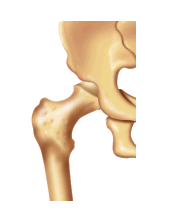The Hip joint is the largest joint in the body and, like the shoulder joint, is a ball and socket joint. The socket is shaped like a horseshoe and is called the acetabulum. The ball is at the top of the thighbone, which is called the femur, and so called the femoral head. This is a synovial joint: it is contained within a capsule lined with synovial membrane that secretes synovial fluid to lubricate movement, and both the ball and the socket are lined by cartilage. There is a considerable range of movement in the hip: we can bend it up (flexion), push it out to the side (abduction), pull it across the midline (adduction), push it behind us (extension), combine these four in order to move it in a circle (circumduction) and twist it around its own axis (rotation). The joint is stabilised by a number of tough ligaments and acted upon by a number of powerful muscles such as those, called the glutei, which make up the buttock and help to rotate and extend the hip.
|

